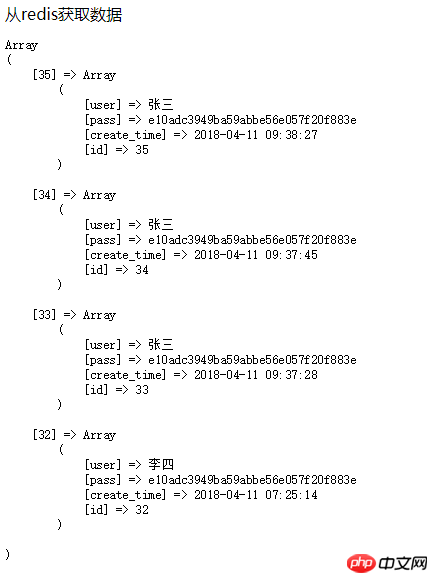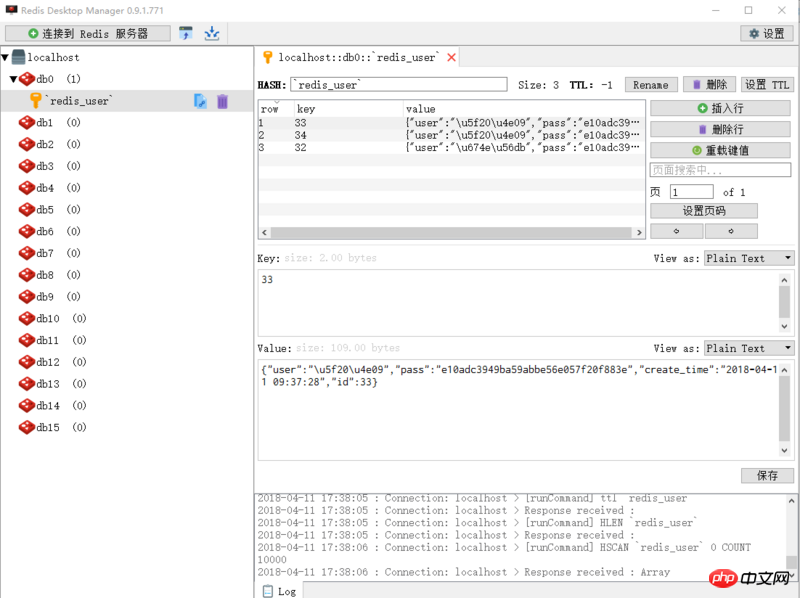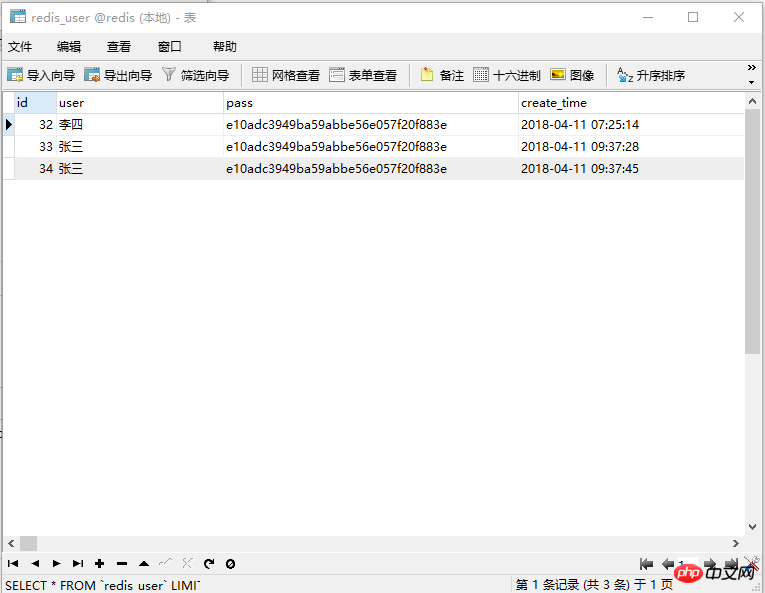Getting started with php plus redis and simple applications
The content of this article is to share with you the introduction and simple application of PHP plus redis. It has a certain reference value. Friends in need can refer to it
1. Experimental environment: win10 redis3. 2 php7
2. Installation of php-redis / redis /redis graphic management tools, etc., skip this step;
3. Five commonly used data types in redis , no detailed explanation
Reference: http://www.runoob.com/redis/r...
4. PHP mysql redis simple application
Database name :redis data table: redis_user
Simulate php operation Mysql redis CURD operation
1, config.php configuration file
<?php
$config = array(
'mysql'=>array(
'host'=>'127.0.0.1',
'user'=>'root',
'pass'=>'root',
'dbname'=>'redis',
'prefix'=>'redis_'
),
'redis'=>array(
'host'=>'127.0.0.1',
'port'=>6379
)
);index.php entry file, please use the primary key ID when operating Mysql
<?php reqiure_once('Mysql.php'); //增加数据 // echo Mysql::getInstance()->table('user')->insert(['user'=>'张三','pass'=>md5('123456'),'create_time'=>date('Y-m-d H:i:s')]); //删除数据 // echo Mysql::getInstance()->table('user')->where(array('id'=>30))->delete(); //查看单条数据 // $data = Mysql::getInstance()->table('user')->where(array('id'=>'30'))->find(); // print_r($data); //查找所有数据 // $all = Mysql::getInstance()->table('user')->field('id,user')->select(); $all = Mysql::getInstance()->table('user')->select(); print_r($all); //修改数据 // echo Mysql::getInstance()->table('user')->where(array('id'=>30))->update(['user'=>'张三adfadfasdf11111111','pass'=>md5('123456aaa')]); ?>



<?php
class Mysql
{
static $instance;
private $conn;
private $redis;
private $options = array();
//单例模式
private function __construct()
{
error_reporting(E_ALL^E_NOTICE^E_WARNING);
require_once(__DIR__.'/Config.php');
$conn = mysqli_connect($config['mysql']['host'],$config['mysql']['user'],$config['mysql']['pass'],$config['mysql']['dbname']);
if(mysqli_connect_errno($conn)) {
echo "连接Mysql失败:".mysqli_connect_error();
exit;
}
mysqli_query($conn,'set names utf8');
$this->options['prefix'] = $config['mysql']['prefix'];
$this->conn = $conn;
$this->redis = new Redis();
$this->redis->connect($config['redis']['host'],$config['redis']['port']);
}
//获取对象实例
static function getInstance()
{
if(self::$instance) {
return self::$instance;
} else {
self::$instance = new self();
return self::$instance;
}
}
//设置表名
public function table(string $table)
{
$this->options['table'] = '`'.$this->options['prefix'].$table.'`';
return $this;
}
//设置redis键名
public function redis(string $key)
{
$this->options['key'] = $key;
return $this;
}
//设置条件
public function where(array $where)
{
$condition = '';
$and = count($where) > 1 ? ' and ' : '';
foreach ($where as $key => $value) {
if($key == 'id') {$this->options['user_id'] = $value;}
if(strpos($key,':')) {
$arr = explode(':', $key);
$condition .= '`'.$arr['0'].'` '.$arr['1']. ' "'.$value.'" ' . $and ;
} else {
$condition .= '`'.$key.'` = ' .'"'.$value.'"' .$and ;
}
}
$this->options['where'] = rtrim($condition,' and ');
return $this;
}
//设置字段
public function field(string $field)
{
$this->options['field'] = $field;
return $this;
}
//增加数据
public function insert(array $data)
{
$key = '`'.implode('`,`', array_keys($data)).'`';
$value = '"'.implode('","', $data).'"';
$sql = "insert into {$this->options['table']} (".$key.") values (".$value.");";
if( mysqli_query($this->conn,$sql) ) {
$user_id = $this->conn->insert_id;
$data['id'] = $user_id;
//以hash类型存储
$this->redis->hset($this->options['table'],$user_id,json_encode($data));
return $user_id;
} else {
return 0;
}
}
//删除数据
public function delete()
{
$where = $this->options['where'] ? $this->options['where'] : '1';
$sql = "delete from {$this->options['table']} where {$where};";
if(mysqli_query($this->conn,$sql)) {
$this->redis->hdel($this->options['table'],$this->options['user_id']);
return 1;
} else {
return 0;
}
}
//修改数据
public function update(array $data)
{
$condition = '';
$where = $this->options['where'] ? $this->options['where'] : '1';
foreach ($data as $key => $value) {
$condition .= ", `".$key."` = '".$value."'";
}
$condition = substr($condition, 1);
$sql = " update {$this->options['table']} set {$condition} where {$where} ; ";
if(mysqli_query($this->conn,$sql)) {
$hashData = (array)json_decode($this->redis->hget($this->options['table'],$this->options['user_id']));
foreach ($data as $key => $value) {
$hashData[$key] = $value;
}
$this->redis->hset($this->options['table'],$this->options['user_id'],json_encode($hashData));
return 1;
} else {
return 0;
}
}
//查找单条数据
public function find()
{
$field = $this->options['field'] ? $this->options['field'] : '*';
$where = $this->options['where'] ? $this->options['where'] : '1';
if($this->options['user_id']) {
echo '从redis获取数据<pre class="brush:php;toolbar:false">';
$data = (array)json_decode($this->redis->hget($this->options['table'],$this->options['user_id']));
if($field != '*') {
$field = explode(',', $field);
foreach ($field as $value) {
$arr[$value] = $data[$value];
$arr['typ'] = 'redis';
}
return $arr;
}
return $data;
} else {
$sql = " select {$field} from {$this->options['table']} where {$where}; ";
if($query = mysqli_query($this->conn,$sql)) {
return mysqli_fetch_assoc($query);
} else {
return array();
}
}
}
//查找所有数据
public function select()
{
$data = array();
$field = $this->options['field'] ? $this->options['field'] : '*';
$hashData = $this->redis->hgetall($this->options['table']);
if($hashData) {
if($field != '*') {
$field = explode(',', $field);
}
foreach ($hashData as $key => $value) {
$data[$key] = array();
$values = (array)json_decode($value);
if($field != '*') {
foreach ($field as $k => $v) {
$data[$key][$v] = $values[$v];
}
}else{
$data[$key] = $values;
}
}
echo '从redis获取数据<pre class="brush:php;toolbar:false">';
} else {
$sql = " select {$field} from {$this->options['table']} ; ";
if($query = mysqli_query($this->conn,$sql)) {
while ($row = mysqli_fetch_assoc($query)) {
$data[] = $row;
}
}
}
return $data;
}
public function __destruct()
{
mysqli_close($this->conn);
}
}The above is the detailed content of Getting started with php plus redis and simple applications. For more information, please follow other related articles on the PHP Chinese website!

Hot AI Tools

Undresser.AI Undress
AI-powered app for creating realistic nude photos

AI Clothes Remover
Online AI tool for removing clothes from photos.

Undress AI Tool
Undress images for free

Clothoff.io
AI clothes remover

AI Hentai Generator
Generate AI Hentai for free.

Hot Article

Hot Tools

Notepad++7.3.1
Easy-to-use and free code editor

SublimeText3 Chinese version
Chinese version, very easy to use

Zend Studio 13.0.1
Powerful PHP integrated development environment

Dreamweaver CS6
Visual web development tools

SublimeText3 Mac version
God-level code editing software (SublimeText3)

Hot Topics
 PHP 8.4 Installation and Upgrade guide for Ubuntu and Debian
Dec 24, 2024 pm 04:42 PM
PHP 8.4 Installation and Upgrade guide for Ubuntu and Debian
Dec 24, 2024 pm 04:42 PM
PHP 8.4 brings several new features, security improvements, and performance improvements with healthy amounts of feature deprecations and removals. This guide explains how to install PHP 8.4 or upgrade to PHP 8.4 on Ubuntu, Debian, or their derivati
 How To Set Up Visual Studio Code (VS Code) for PHP Development
Dec 20, 2024 am 11:31 AM
How To Set Up Visual Studio Code (VS Code) for PHP Development
Dec 20, 2024 am 11:31 AM
Visual Studio Code, also known as VS Code, is a free source code editor — or integrated development environment (IDE) — available for all major operating systems. With a large collection of extensions for many programming languages, VS Code can be c
 How do you parse and process HTML/XML in PHP?
Feb 07, 2025 am 11:57 AM
How do you parse and process HTML/XML in PHP?
Feb 07, 2025 am 11:57 AM
This tutorial demonstrates how to efficiently process XML documents using PHP. XML (eXtensible Markup Language) is a versatile text-based markup language designed for both human readability and machine parsing. It's commonly used for data storage an
 PHP Program to Count Vowels in a String
Feb 07, 2025 pm 12:12 PM
PHP Program to Count Vowels in a String
Feb 07, 2025 pm 12:12 PM
A string is a sequence of characters, including letters, numbers, and symbols. This tutorial will learn how to calculate the number of vowels in a given string in PHP using different methods. The vowels in English are a, e, i, o, u, and they can be uppercase or lowercase. What is a vowel? Vowels are alphabetic characters that represent a specific pronunciation. There are five vowels in English, including uppercase and lowercase: a, e, i, o, u Example 1 Input: String = "Tutorialspoint" Output: 6 explain The vowels in the string "Tutorialspoint" are u, o, i, a, o, i. There are 6 yuan in total
 7 PHP Functions I Regret I Didn't Know Before
Nov 13, 2024 am 09:42 AM
7 PHP Functions I Regret I Didn't Know Before
Nov 13, 2024 am 09:42 AM
If you are an experienced PHP developer, you might have the feeling that you’ve been there and done that already.You have developed a significant number of applications, debugged millions of lines of code, and tweaked a bunch of scripts to achieve op
 Top 10 PHP CMS Platforms For Developers in 2024
Dec 05, 2024 am 10:29 AM
Top 10 PHP CMS Platforms For Developers in 2024
Dec 05, 2024 am 10:29 AM
CMS stands for Content Management System. It is a software application or platform that enables users to create, manage, and modify digital content without requiring advanced technical knowledge. CMS allows users to easily create and organize content
 How to Add Elements to the End of an Array in PHP
Feb 07, 2025 am 11:17 AM
How to Add Elements to the End of an Array in PHP
Feb 07, 2025 am 11:17 AM
Arrays are linear data structures used to process data in programming. Sometimes when we are processing arrays we need to add new elements to the existing array. In this article, we will discuss several ways to add elements to the end of an array in PHP, with code examples, output, and time and space complexity analysis for each method. Here are the different ways to add elements to an array: Use square brackets [] In PHP, the way to add elements to the end of an array is to use square brackets []. This syntax only works in cases where we want to add only a single element. The following is the syntax: $array[] = value; Example
 Which country is the Nexo exchange from? Where is it? A comprehensive introduction to the Nexo exchange
Mar 05, 2025 pm 05:09 PM
Which country is the Nexo exchange from? Where is it? A comprehensive introduction to the Nexo exchange
Mar 05, 2025 pm 05:09 PM
Nexo Exchange: Swiss cryptocurrency lending platform In-depth analysis Nexo is a platform that provides cryptocurrency lending services, supporting the mortgage and lending of more than 40 crypto assets, fiat currencies and stablecoins. It dominates the European and American markets and is committed to improving the efficiency, security and compliance of the platform. Many investors want to know where the Nexo exchange is registered, and the answer is: Switzerland. Nexo was founded in 2018 by Swiss fintech company Credissimo. Nexo Exchange Geographical Location and Regulation: Nexo is headquartered in Zug, Switzerland, a well-known cryptocurrency-friendly region. The platform actively cooperates with the supervision of various governments and has been in the US Financial Crime Law Enforcement Network (FinCEN) and Canadian Finance






